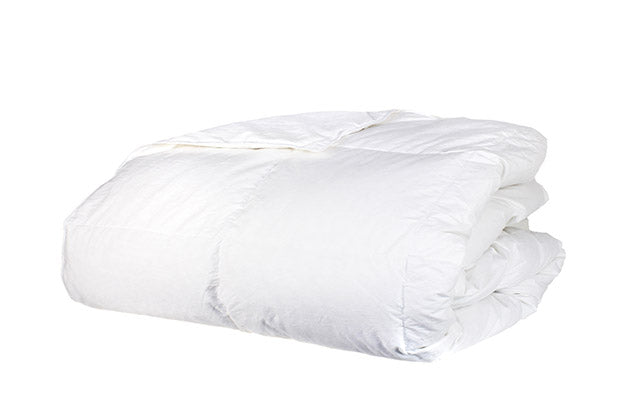Down Comforters: A Guide

Down Comforter Buying Guide
What is Down, anyway?
Down is the feather undercoat of a bird used for its natural, lightweight, insulated material. It provides the insulation birds need to keep warm. Down is used in bedding, jackets, pillows, and sleeping bags.
Types of Down
Goose Down – This type of down is what you would find in most quality down comforters. Goose clusters tend to be large and come from older birds. Larger clusters allow for higher fill powers and durability. Clusters can be white or gray but white is generally preferred since it will camouflage with a white comforter shell.
The highest fill for goose is generally 1000 FP.
Synthetic (Down Alternative) – Many opt-in for a synthetic fill such as cotton, wool or polyester.
Fill Power

Quite simply, fill power is a measurement of the amount of space one ounce of down will occupy in cubic inches. The higher the fill power, the larger the down clusters. Larger down clusters yield better insulation. The larger the down cluster, the lighter the down comforter (or pillow, jacket, featherbed, etc…) will be.
400 Fill Power and Below Fill Power- Soft and Lightweight warmth. Perfect for warmer climates or warm sleepers.
400 - 599 Fill Power – Lightweight, but more insulated. Perfect for all seasons and couples who sleep at different temperatures.
600 - 799 Fill Power – Lightweight and great for the winter season and cold climates.
800 and Up Fill Power – Highest insulation for winter warmth and cold climates.
Shell &
Thread Count
Thread count is usually associated with sheets, but it is also a factor when shopping for down. Just like with bedding, a higher thread count means a tighter weave. When it comes to down, a higher thread count and tighter weave will determine how well it contains the fill, making it last longer.
Our comforters are made with 100% Cotton Shell with thread counts between 280 and 480.
Care
To prolong the life of your comforter, we recommend to seldom wash your comforter. Instead, use a duvet cover to protect the comforter and wash the duvet cover regularly.
When it is time to wash and dry your comforter, refer to our Down Comforter Washing Guide.
